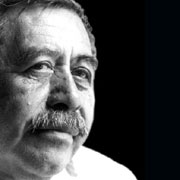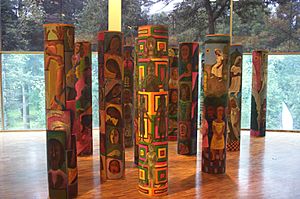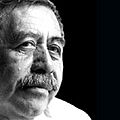Rodolfo Morales facts for kids
Quick facts for kids
Rodolfo Morales
|
|
|---|---|
 |
|
| Born | May 8, 1925 |
| Died | January 30, 2001 (aged 75) |
Rodolfo Morales (May 8, 1925 – January 30, 2001) was a famous Mexican painter. He was known for adding elements of magic realism to his art. This means his paintings often mixed real life with dream-like or magical ideas.
Morales is most famous for his bright, colorful paintings and collages. These often showed Mexican women in village settings, looking like they were part of a dream. He also helped restore old buildings in Ocotlán de Morelos. Along with other famous artists like Rufino Tamayo and Francisco Toledo, he helped make Oaxaca a key place for contemporary art and tourism in Southern Mexico. Until he passed away in 2001, many people thought he and Toledo were Mexico's greatest living artists.
Contents
Early Life and Art Journey
Rodolfo Morales was a Zapotec Native American. He was born in the small town of Ocotlán de Morelos. As a child, he was often quiet and found comfort in drawing. From 1948 to 1953, he studied art at the Academy of San Carlos in Mexico City.
After graduating, he became a drawing teacher. He taught art for 32 years at Escuela Nacional Preparatoria, from 1953 to 1985. In 1965, he used collages to decorate a Christmas party. A sculptor friend, Geles Cabrera, saw his work and loved it. She offered to trade one of her sculptures for one of his paintings.
This made Morales want to focus more on painting. To earn extra money, he started showing his art in small galleries in Mexico City. In 1975, when he was almost 50, Cabrera convinced him to have his first big art show. It was at the Casa de las Campanas Art Gallery in Cuernavaca. There, the famous Mexican painter Rufino Tamayo noticed his work. Tamayo helped Morales connect with art critics and galleries around the world. This led to many group and solo art shows for Morales.
Later Years and Community Work
By 1985, Morales had earned enough money to stop teaching. He moved back to Oaxaca to focus on his art and on restoring old buildings. He used money from his art to start the Rodolfo Morales Cultural Foundation. This foundation worked to restore buildings in his hometown of Ocotlán.
He helped pay for the restoration of fifteen churches. This included the old 16th-century Convent of Santo Domingo. He also helped restore a 17th-century church in Santa Ana Zegache. He created cultural spaces across Oaxaca's central valleys. His most important project was turning the old convent of Ocotlan into a town center.
Morales made sure that local women did much of the restoration work. This helped them learn new skills and find jobs later. His foundation also set up a computer room for young people to learn technology. They gave materials to new artists and made art prints to help teach people about AIDS. They even planted new copal trees to make the area beautiful and provide wood for making carved animals.
Even while working on his art, he started each day by making a small collage. He would sell these collages to raise money for his Foundation. Rodolfo Morales passed away on January 30, 2001, at age 75 in Oaxaca. His remains were placed in his restored Convent of Santo Domingo in Ocotlán.
Artistic Style and Themes
Morales's art is often described as dream-like and full of local stories. His paintings often show indigenous people, especially women. They are usually set in rural areas, with old buildings, churches, town squares, and shops. His style was influenced by Mexican artist María Izquierdo and French painter Marc Chagall.
Women and memories were very important in his artwork. Morales once said that Mexico would be lost without the hard work of women. He felt they carried the weight of daily life and solved problems that men often gave up on. In an interview, he explained that he lived in his memories. He said that feeling nostalgic and a bit sad was very important to him. Even so, Morales usually did not talk about the "meaning" of his art. He often created paintings without giving them titles.
His art often features bright colors and figures with exaggerated hands and feet. You might see oversized faces, women (often brides), puppies, flowers, angels, bicycles, and musical instruments. His figures often look like they are floating in a dream.
Most of his work was oil paintings on canvas. But he also created murals, decorated wooden furniture, and unique cardboard pillars. When these pillars were put together, they created a changing display of images and colors as you walked around them. He also made many collages. Some were sold to raise money, while others were detailed sets that told a story. In 1998, a children's book called Angel’s Kite was published with illustrations by Morales made from collages.
Legacy and Impact
The Rodolfo Morales Foundation continues its work today. It helps to protect the history and culture of Oaxaca. It also supports new artists. After his death, the Spring Festival in Oaxaca was renamed the Spring Festival Rodolfo Morales to honor him.
Images for kids
See also
 In Spanish: Rodolfo Morales para niños
In Spanish: Rodolfo Morales para niños




